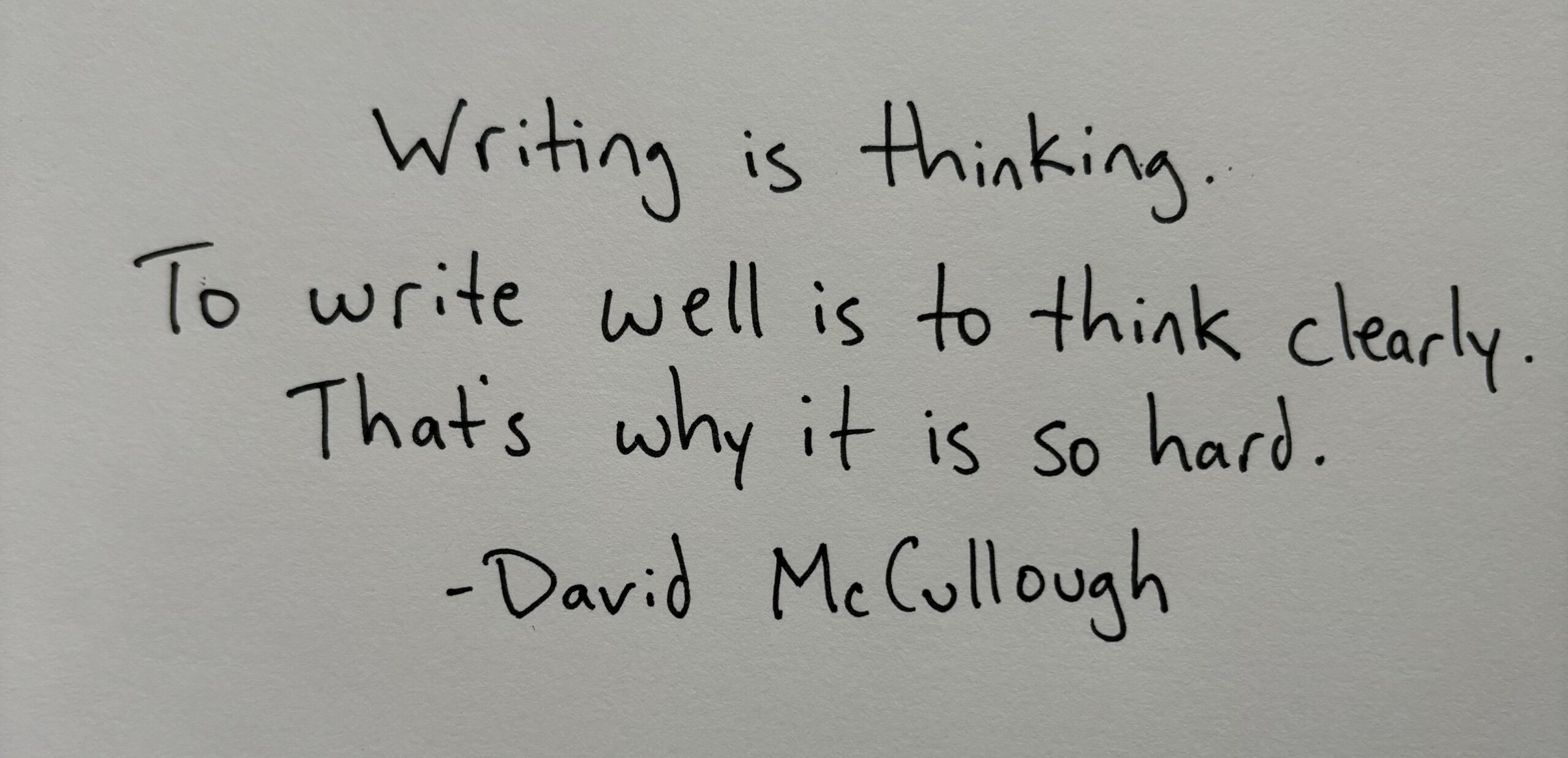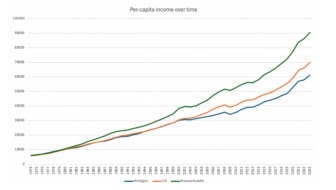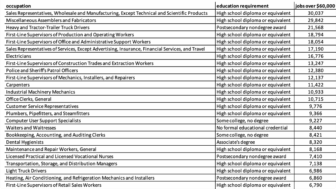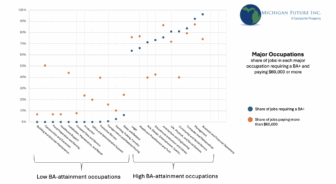Over the next several weeks, I’ll be writing a series of posts about the importance of educational attainment – both to our statewide economy and to individual economic mobility and prosperity – and how we should be designing our K-16 education system to increase the number of Michiganders who attain bachelor’s degrees.
This is the fifth post in the series. In this post, I explore how the K-12 system would need to change to ensure more students are prepared to pursue and attain a four-year degree. See links to previous posts below:
Post #1: Educational attainment and economic development
Post #2: Educational attainment and economic well-being
Post #3: College completion rates
Post #4: Beyond free college
Building an education system designed for college success
In this post I’m going to begin sketching out what a system that is designed to produce many more four-year college graduates would look like. In subsequent posts I’ll spend time on our community college and four-year college systems, but in this post I’m going to start with our K-12 system. And I’m going to start with what is perhaps the single most important skill needed for college success, but that is largely ignored in our K-12 system: the ability to write.
When we talk about K-12 reform the discussion often moves very quickly to test scores. Our schools are failing because too many of our third graders can’t read proficiently, or because our 4th or 8th graders have fallen behind this or that state in math or reading skills.
The problem is that these test scores, while they certainly tell us valuable information about our students’ fluency in math and reading, are not actually a good gauge of the skills students will need to be successful in college, like the ability to write critically, analytically, and clearly. And because there is only so much time in a day, the more time we spend on prepping for tests of basic math and reading, the less time we have available for developing the skills needed to write well, which are increasingly required for college and career success.
Writing for college and career
Lawrence McEnerney, the director of the University of Chicago’s Writing Program, wrote about college:
“For four years, you are asked to read, do research, gather data, analyze it, think about it, and then communicate it to readers in a form in which enables them to assess it and use it. You are asked to do this not because we expect you all to become professional scholars, but because in just about any profession you pursue, you will do research, think about what you find, make decisions about complex matters, and then explain those decisions–usually in writing–to others who have a stake in your decisions being sound ones. In an Age of Information, what most professionals do is research, think, and make arguments. (And part of the value of doing your own thinking and writing is that it makes you much better at evaluating the thinking and writing of others.)” [emphasis added]
I recently read an article describing how Jeff Bezos would run meetings with his senior staff at Amazon. PowerPoint presentations were banned. Rather, the person leading the meeting had to write a six-page narrative memo (no bullets) describing a proposal or idea, raising and then striking down counterarguments or competing proposals, and making the case for why their proposed direction was the one the company should follow.
This is the exact kind of writing that McEnerney is talking about. This is not just any writing, but a specific kind of writing – writing that demonstrates clarity of thought, and a well-supported argument. Indeed, as McEnerney notes and Bezos clearly understands, to be a good writer you need to be a good thinker, and vice versa – thoughts and arguments are often not quite as developed as you think they are until you have to put them down on a page and support them with evidence.
But this is the core skill that, ideally, is developed and refined in college. McEnerney notes that in college you will be asked, nearly every other week “to analyze (a) reading, to make a worthwhile claim about it that is not obvious, to support your claim with good reasons, all in four or five pages that are organized to present an argument.” The authors note that so many students struggle with the transition from high school to college because the writing that instructors are asking for is “not just something better, but something different.” No longer does it suffice to summarize a work (though students often struggle with this as well) or follow a formulaic path; rather, to excel, students must make an original claim, and then effectively back up that claim with evidence.
Struggling writers
The trouble is, if this is a skill students have long struggled with, by all accounts this trend is only accelerating. Trade publications and the popular press are filled with articles by college faculty and writing instructors, bemoaning the declining ability of their students to string together coherent, well-researched arguments. One potential culprit, it seems, is the test-based accountability movement sparked by No Child Left Behind (NCLB), and the Common Core standards that followed in its wake. Thought initially to be a mechanism to introduce some sense of accountability, uniformity, and rigor to the American K-12 curriculum, NCLB and the Common Core standards have now been accused of turning millions of American high school students into poor readers and writers. Students are not taught to write, per se, but are taught a formula for a five-paragraph essay. Students don’t read books, but rather test-ready short passages.
Marc Tucker, the founder and former president of the National Center on Education and the Economy writes that “high school students are hardly ever asked to write anything of significant length. Why not? Because in this age of accountability, they are not tested on their writing ability. By which I mean that they are not asked to submit to the testing authorities 10- or 15- or 20-page papers in which they are expected to present a thesis and defend it, analyze something complicated from multiple points of view and draw a reasoned conclusion.”
He goes on to say that the only way to learn how to do it, like almost anything else, is to do it – a lot. But our current K-12 system is not designed to encourage this kind of practice. It is designed for students to do well on standardized tests, by practicing the kinds of questions that appear on standardized tests, which, by their very presence on standardized tests, are intellectually shallow. Time to work on the foundations of writing a solid argument – of finding your thesis, of conducting research to find data that backs that thesis, of entertaining and then striking down counterarguments, of truly and rigorously exploring ideas and claims – has not been carved into the school day.
Yet Tucker, like McEnerney, also believes that clear, critical writing is the core skill we should be centering education around in the 21st century. Tucker writes, “We are fond of producing long lists of things we want 21st century students to be able to do. But the ability to write well and think critically always tops the list, both because so much work requires these skills and because they are so fundamental to so many other kinds of cognitive activity we value. What could be more central to a good education?”
And it’s not just the tricky transition from high school writing to college writing that is giving students trouble. There is ample evidence that most American high school students can’t write in even the most basic sense – that is, writing in complete sentences with appropriate grammar, or writing sentences that build off one another to create a paragraph with a main idea. Roughly 75 percent of twelfth graders taking the National Assessment of Educational Progress were deemed not proficient writers, and 40 percent of students who took the ACT did not have the skills needed to be successful in a first-year college writing course. Again, the likely culprit is the two decades of high-stakes test driven accountability brought on by No Child Left Behind, which appears to have pushed out whatever meager amount of writing was previously in the K-12 curriculum.
In my next post, I’ll dig into other essential elements of college readiness that our K-12 system ignores, and offer some ideas for what we can do about paying them more attention.







